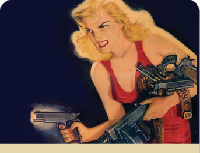From the
Introduction by
Black Mask
Magazine Publisher and Owner
Keith Alan Deutsch

THIS PANORAMIC COLLECTION OF stories and novels from Black Mask magazine (1920 to 1951) is the most comprehensive presentation of the hard-boiled tradition of writing ever published from this great magazine. I believe this is a significant publishing event because Black Mask introduced the hard-boiled detective, and a new style of narration, to American literature.
In many ways, Black Mask took the nineteenth-century American Western tale of outlaws and vigilante justice from its home on the range in dime novels, and transplanted that mythic tale to the crooked streets of America’s emerging twentieth-century cities. It introduced a new landscape for both American adventures of justice and also a new kind of narration told with the vernacular language of the streets, and featuring new urban villains, and urban (if not always urbane) heroes for the mystery story. . . .
Both the hard-boiled and the noir genres invented in Black Mask by writers who wrote for the magazine and later wrote for radio and film in the 1930s and 1940s, and finally for television in the 1950s, still inform many of the genres that dominate entertainment in all our modern, digital media, from computer games to global film franchises. Every period from the magazine’s influential history is represented in this definitive anthology. All but a few historically significant stories of the more than fifty tales in the collection have never been reprinted before.
One story, “Luck,” by Lester Dent, is an unpublished discovery of some note: a completely rewritten version of Dent’s often anthologized and much praised classic tale “Sail,” which is introduced for the first time in this volume thanks to the help of Will Murray and Dent’s estate.
Also newsworthy is the first book publication of two major Black Mask novels in their original serialized format with Arthur Rodman Bowker’s magnificent illustrated headings, and all the original editorial comments to each segment. The iconic The Maltese Falcon by Dashiell Hammett and the long-lost
Rainbow Murders by Raoul Whitfield are alone worth the price of admission to this generous collection.
Included also are many of the most popular series characters that were featured over the years: Sam Spade, the Continental Op , Race Williams, Mike Shayne, Flashgun Casey, Bill Lennox (Hollywood Troubleshooter), Oliver Quade (the Human Encyclopedia), Ed Jenkins (the Phantom Crook), Jo Gar (the Little Island Detective), Jerry Frost of the Texas Air Rangers, Kennedy and MacBride of Richmond City, and Raymond Chandler’s precursor to Philip Marlowe.
Also in the lineup, most for the first time in any book, are less well-known recurring characters who in their time were an important mainstay of the magazine’s identity, and who still retain their original charm: Black Mask’s first series character, Ray Cummings’s “honest” underworld rogue Timothy McGuirk, who starred in fourteen tales from 1922 to 1926; the first of D. L. Champion’s twenty-six funny tales starring Rex Sackler; Dale Clark’s house dick O’Hanna appeared in twenty-eight stories; the first of Julius Long’s seventeen Ben Corbett tales; one of seven Cellini Smith mysteries by Robert Reeves (typically titled “Blood, Sweat and Biers” by Ken S. White, Black Mask’s editor in the 1940s); one of nine “Special Squad” stories by Stewart Sterling that each feature an expert division of the New York Police Department; and one of Theodore A. Tinsley’s twenty-five tales starring the wisecracking newspaper columnist Jerry Tracy.
These series characters provided continuity to the run of the magazine issues, and helped maintain reader interest. When featured on the cover, Race Williams, Ed Jenkins, or the Continental Op could increase newsstand sales by ten percent or more.
Speaking of popularity, it should be noted that Black Mask quite early on developed a deserved reputation for attracting the most distinguished and respected thinkers and writers among its readership. . . . Even before Hammett’s first novels were published as books in 1929, and certainly by the time
The Maltese Falcon ran in the magazine in 1929 and 1930, Black Mask was being read and discussed by notable readers around the world.
In an interview with editor Joseph Shaw in
Author and Composer magazine in August 1932, Ed Bodin (a pulp fiction agent of the time) mentions that Black Mask is read in the White House.
. . . By February of 1934, in Writer’s Review, in an article called “Are Pulp Readers Kid-Minded?” Joseph Shaw is quoted as “receiving letters from the most intelligent people in the country,” and reporting “President Roosevelt , J. P. Morgan and Herbert Hoover read Black Mask for relaxation.”
In Philadelphia, as a graduate student on a tour of their late residence (now a museum), I discovered that Philip Rosenbach and his younger brother Dr. A. S. W. Rosenbach, the preeminent dealers of rare books, manuscripts, and decorative arts during the first half of the twentieth century, were, from early in its run, Black Mask subscribers and collectors. More than any other pulp fiction magazine, Black Mask was recognized for the quality and for the cultural significance of its writing. With the growing literary reputations of Hammett and Chandler, now generally accepted as major American writers of the twentieth century, Black Mask’s cultural significance continues to grow.









